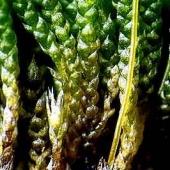Please select root levels for the menu
NZ Plants
Tayloria callophylla - dung moss
Family: Splachnaceae
-
A mat of plants cut open
L Jensen
View picture -
Upper portion of stems
L Jensen
View picture -
Shoot
L Jensen
View picture -
Shoot
L Jensen
View picture -
Leaves
L Jensen
View picture -
Dry shoot
L Jensen
View picture -
Detached leaf
L Jensen
View picture -
Leaf margin
L Jensen
View picture -
Stem, tomentum of rhizoids
L Jensen
View picture -
Rhizoids
L Jensen
View picture -
Young sporophyte plant with stalk (seta) and terminal capsule with calyptra cover
L Jensen
View picture -
Perichaetial bracts at base of seta
L Jensen
View picture -
Calyptra
L Jensen
View picture -
Cayptra covering an immature capsule
L Jensen
View picture -
Calyptra
L Jensen
View picture -
Calyptra removed to show the operculum lid
L Jensen
View picture -
Operculum of a young capsule
L Jensen
View picture -
Mature capsule with glands
L Jensen
View picture -
Capsule glands
L Jensen
View picture -
Capsule peristome with spores, from above
L Jensen
View picture -
Peristome of empty capsule, from above
L Jensen
View picture -
Peristome with spores in side view
L Jensen
View picture
Tayloria callophylla has stems up to 6 cm tall and forms loose cushions matted together with an orange to red tomentum. The greenish-gray obovate to elliptic leaves are up to 4 mm long and run out into a long hair point in leaves at the top of the stem. The distal portion of leaves have margins with large blunt teeth.
Mosses in this family are unique in having a symbiotic relationship with flies (dipterans). The glands on the capsule release volatile, aromatic, fly-attracting compounds and spores are extruded in a cohesive, sticky mass.
Found mainly in the North Island on decaying organic matter especially animal carcasses and faeces.




